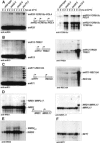Functions for S. cerevisiae Swd2p in 3' end formation of specific mRNAs and snoRNAs and global histone 3 lysine 4 methylation
- PMID: 15146080
- PMCID: PMC1370588
- DOI: 10.1261/rna.7090104
Functions for S. cerevisiae Swd2p in 3' end formation of specific mRNAs and snoRNAs and global histone 3 lysine 4 methylation
Abstract
The Saccharomyces cerevisiae WD-40 repeat protein Swd2p associates with two functionally distinct multiprotein complexes: the cleavage and polyadenylation factor (CPF) that is involved in pre-mRNA and snoRNA 3' end formation and the SET1 complex (SET1C) that methylates histone 3 lysine 4. Based on bioinformatic analysis we predict a seven-bladed beta-propeller structure for Swd2p proteins. Northern, transcriptional run-on and in vitro 3' end cleavage analyses suggest that temperature sensitive swd2 strains were defective in 3' end formation of specific mRNAs and snoRNAs. Protein-protein interaction studies support a role for Swd2p in the assembly of 3' end formation complexes. Furthermore, histone 3 lysine 4 di-and tri-methylation were adversely affected and telomeres were shortened in swd2 mutants. Underaccumulation of the Set1p methyltransferase accounts for the observed loss of SET1C activity and suggests a requirement for Swd2p for the stability or assembly of this complex. We also provide evidence that the roles of Swd2p as component of CPF and SET1C are functionally independent. Taken together, our results establish a dual requirement for Swd2p in 3' end formation and histone tail modification.
Figures






References
-
- Alen, C., Kent, N.A., Jones, H.S., O’Sullivan, J., Aranda, A., and Proudfoot, N.J. 2002. A role for chromatin remodeling in transcriptional termination by RNA polymerase II. Mol. Cell 10: 1441–1452. - PubMed
-
- Bentley, D. 2002. The mRNA assembly line: Transcription and processing machines in the same factory. Curr. Opin. Cell. Biol. 14: 336–342. - PubMed
Publication types
MeSH terms
Substances
LinkOut - more resources
Full Text Sources
Other Literature Sources
Molecular Biology Databases
